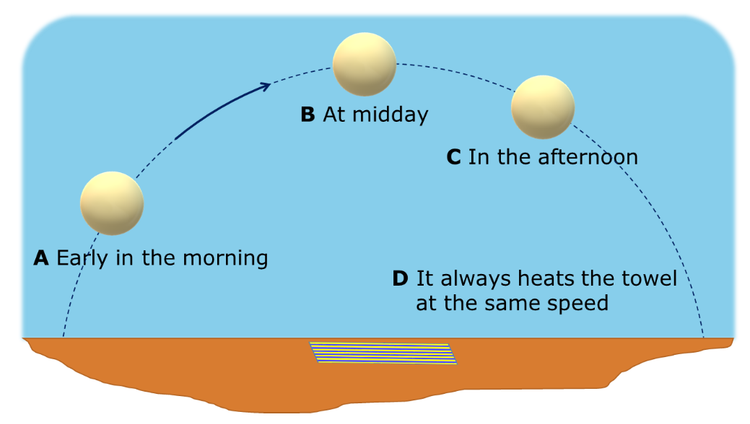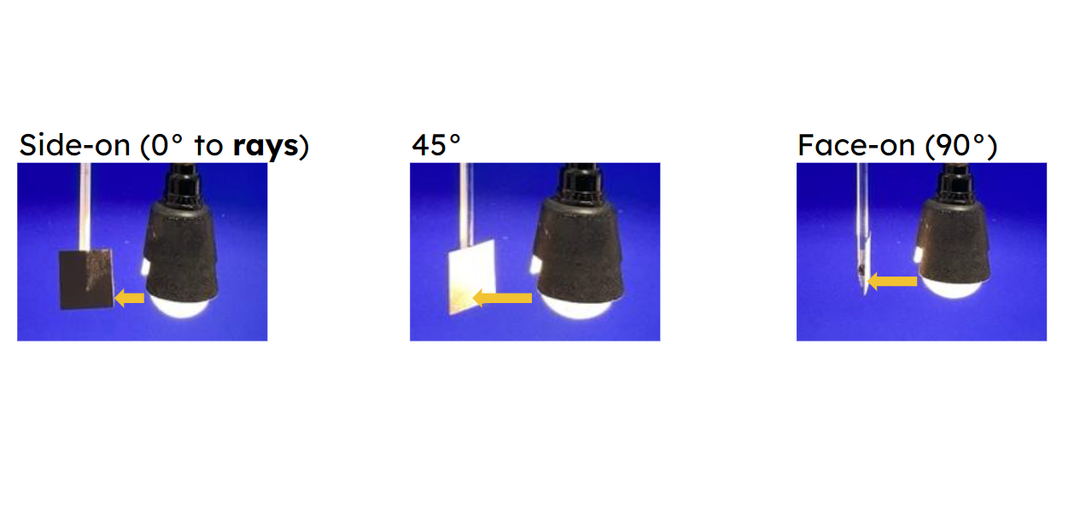Myths about teaching can hold you back
- Year 7
Heating by the Sun
I can explain why the heating effect of the Sun is greater at midday than at sunrise.
- Year 7
Heating by the Sun
I can explain why the heating effect of the Sun is greater at midday than at sunrise.
These resources will be removed by end of Summer Term 2025.
Switch to our new teaching resources now - designed by teachers and leading subject experts, and tested in classrooms.
These resources were created for remote use during the pandemic and are not designed for classroom teaching.
Lesson details
Key learning points
- Heating a surface from directly overhead is more effective than heating a surface at a different angle.
- When rays of light hit a surface face-on, they are less spread out than if they hit at an angle.
- At a place on Earth, the heating effect of the Sun is greatest at midday and lowest at sunrise and sunset.
- Over a day, Earth's spin changes the Sun's height in the sky and the angle at which the Sun's rays arrive at a place.
Keywords
Heating - Anything that raises the temperature of an object is heating the object.
Ray - Rays are straight lines with arrowheads, drawn to represent light.
Angle - An angle measures the difference between two directions, in degrees.
Thermometer - A thermometer is used to measure temperature in degrees Celsius.
Common misconception
Students may think that the midday Sun is higher in the sky because the Sun is further away then, or that the midday Sun has a greater heating effect because the Sun is closer or hotter then.
Use physical models (such as a globe, or a flat card in front of a light bulb with a thermometer attached) to show students how the changes observed over a day to Sun's position in the sky and the Sun's heating effect are caused by Earth's spin.
To help you plan your year 7 science lesson on: Heating by the Sun, download all teaching resources for free and adapt to suit your pupils' needs...
To help you plan your year 7 science lesson on: Heating by the Sun, download all teaching resources for free and adapt to suit your pupils' needs.
The starter quiz will activate and check your pupils' prior knowledge, with versions available both with and without answers in PDF format.
We use learning cycles to break down learning into key concepts or ideas linked to the learning outcome. Each learning cycle features explanations with checks for understanding and practice tasks with feedback. All of this is found in our slide decks, ready for you to download and edit. The practice tasks are also available as printable worksheets and some lessons have additional materials with extra material you might need for teaching the lesson.
The assessment exit quiz will test your pupils' understanding of the key learning points.
Our video is a tool for planning, showing how other teachers might teach the lesson, offering helpful tips, modelled explanations and inspiration for your own delivery in the classroom. Plus, you can set it as homework or revision for pupils and keep their learning on track by sharing an online pupil version of this lesson.
Explore more key stage 3 science lessons from the Our solar system and beyond unit, dive into the full secondary science curriculum, or learn more about lesson planning.

Equipment
Content guidance
- Risk assessment required - equipment
Supervision
Adult supervision required
Licence
Prior knowledge starter quiz
6 Questions
Q1.Which two of these astronomical objects give off light (are luminous)?
Q2.What causes a parked car to heat up to a higher temperature than its surroundings on a sunny day?
Q3.Which of these days in the northern hemisphere (e.g. in London) has most hours of daylight?
Q4.Put these planets in order of how bright the sun appears from each one. Start with the one where the sun appears brightest.
Q5.Put these planets in order of their average temperature, starting with the hottest.
Q6.Which of these cars would be the hottest? Apart from colour, the cars are identical.
Assessment exit quiz
6 Questions
Q1.Which produces the greatest heating effect?
Q2.Starting with sunrise, put these positions that the Sun appears in the sky (from the UK) into the order they occur during a day.
Q3.The picture shows the path of the Sun across the sky during one day at a beach. A towel is laid out across the ground. At which point in the day is the towel heated most strongly by the Sun?

Q4.Why is heating a surface from directly overhead (or ‘face-on’) more effective than heating a surface at a different angle?
Q5.What is the correct reason why the heating effect of the Sun is greater at midday/noon than at sunrise?
Q6.Izzy is investigating how the heating angle affects the temperature rise of a card in two minutes. Match the variables in this investigation.

the angle of the surface to the rays
the temperature rise in two minutes
the distance between the centre of the card and the heater


